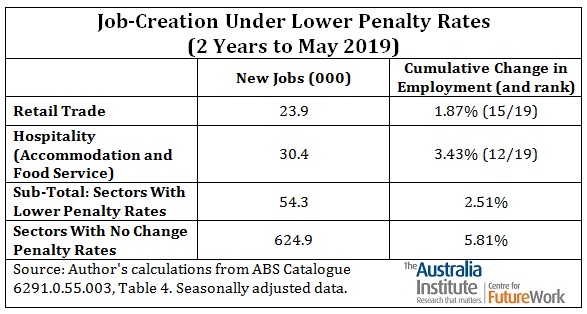Update on Penalty Rates and Job-Creation: Two Years Later
Author
July 1 marked the implementation of the next stage of reduced penalty rates in the retail and hospitality industries in Australia. It is now two full years since the first reductions were imposed for Sunday and holiday work in several segments of retail and hospitality. Once fully phased in, these reductions will reduce wage payments in the two broad industries by an estimated $1.25 billion per year – at a time when concerns over weak wages and their impacts on the Australian economy are growing.
Employers argued before the Fair Work Commission that if their Sunday and holiday labour costs were reduced, they would hire more workers, and the Commission cited this logic in accepting employer demands for lower penalties. Now, with two full years of experience since the first reductions, there is growing evidence that the penalty rate reductions have not spurred job creation in retail and hospitality. To the contrary, our new report shows that employment growth in retail and hospitality has been far slower than in other parts of the economy (where penalty rates remained constant) — and job-growth in the two sectors actually slowed by more than half after penalty rates began to fall.
This briefing paper, authored by Dr Jim Stanford (Director and Economist of the Centre for Future Work) reviews disaggregated employment statistics for 19 Australian industries in the two years after the first penalty rate reductions were imposed on 1 July, 2017.
The retail sector created 24,000 new jobs in the two years since 1 July 2017, and the broad hospitality sector (including accommodation and food & beverage services) created 30,000. In both cases, over 100% of the new jobs were part-time — both sectors actually shed full-time work during this period. The rate of job-creation was less than half as fast during the last two years in both sectors, as it had been in the two years before penalty rate cuts began — even though the pace of job-creation in the broader economy accelerated during the last two years.

The retail sector ranked 15th out of 19 sectors in job-creation over the past two years; hospitality ranked 12th. Their combined rate of job-creation (up by 2.5% over the two years) was less than half the combined rate of job-creation in the 17 sectors which had no change in penalty rates. 92% of all jobs created in the last two years were created in sectors with constant penalty rates. The two sectors with reduced penalty rates created just 8% of new jobs in this period — even though they accounted for 18% of total employment at the time the penalty rate reductions began.
It is clear that lower penalty rates have not ignited new hiring in either of these sectors. Instead, job-creation in both sectors has deteriorated well below economy-wide averages in this period. Clearly it takes more than cheapening labour costs to create jobs. Stronger consumer spending (a goal which would be supported by higher wages, not lower wages) is far more important to hiring decisions in these two domestic service industries.